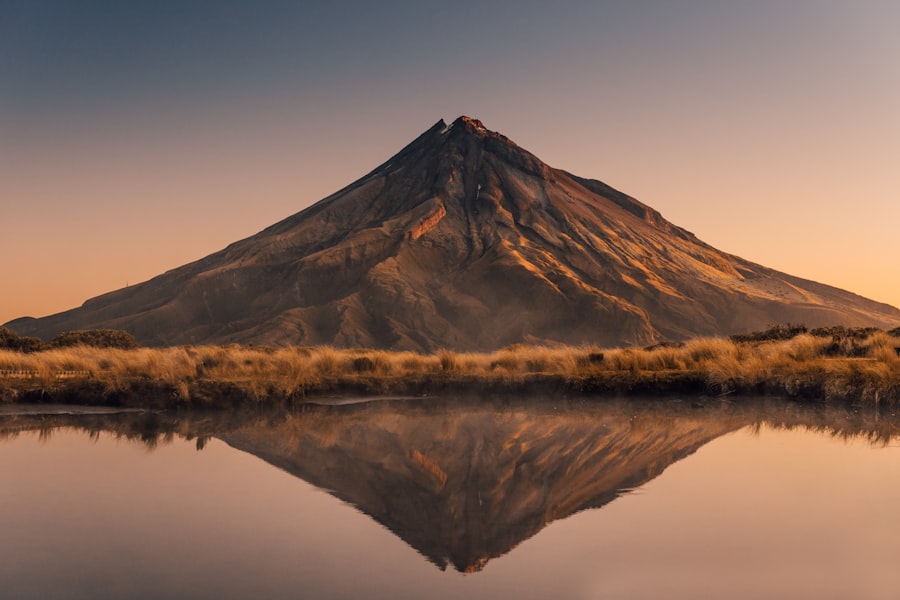Volcanic eruptions have long captivated the human imagination, evoking both awe and fear. These natural phenomena occur when magma from beneath the Earth’s crust escapes to the surface, often resulting in explosive displays of power. The sheer force of an eruption can reshape landscapes, create new landforms, and even alter weather patterns.
Throughout history, volcanic eruptions have played a significant role in shaping civilizations, influencing agriculture, and impacting human health. Understanding the dynamics of these eruptions is crucial for both scientific inquiry and public safety. The fascination with volcanic eruptions extends beyond their immediate effects; they also serve as a reminder of the Earth’s dynamic nature.
While some eruptions are relatively benign, others can be catastrophic, leading to loss of life and extensive property damage. As communities continue to develop near volcanic regions, the need for comprehensive knowledge about these geological events becomes increasingly important. This article aims to explore the science behind volcanic eruptions, their various types, historical instances, environmental impacts, and the measures taken to predict and respond to these powerful natural events.
The Science Behind Volcanic Eruptions
At the heart of volcanic eruptions lies a complex interplay of geological processes. The Earth’s interior is composed of layers, with the mantle being a semi-fluid layer beneath the rigid crust. When tectonic plates shift or collide, they can create conditions that allow magma to rise from the mantle.
This magma, composed of molten rock, gases, and crystals, accumulates in magma chambers beneath the surface. As pressure builds within these chambers, it can lead to an eruption. The composition of the magma plays a crucial role in determining the nature of an eruption.
Magma that is rich in silica tends to be more viscous, leading to explosive eruptions characterized by ash clouds and pyroclastic flows. Conversely, basaltic magma, which is lower in silica, is less viscous and typically results in effusive eruptions where lava flows steadily from a vent. The gases dissolved in the magma also contribute to the eruption’s intensity; as pressure decreases during an ascent, these gases expand rapidly, propelling magma outwards with tremendous force.
Types of Volcanic Eruptions

Volcanic eruptions can be classified into several distinct types based on their characteristics and behavior. Among the most common types are explosive eruptions and effusive eruptions. Explosive eruptions are marked by violent outbursts that eject ash, gas, and volcanic rock high into the atmosphere.
These eruptions can create towering plumes that can be seen from miles away and can have devastating effects on nearby communities. In contrast, effusive eruptions are characterized by the gentle flow of lava from a volcano’s vent. These eruptions often result in the formation of shield volcanoes, which have broad, gently sloping sides due to the low viscosity of basaltic lava.
While effusive eruptions may not seem as dramatic as their explosive counterparts, they can still pose significant risks, particularly if lava flows threaten populated areas or infrastructure. Another notable type of eruption is the phreatomagmatic eruption, which occurs when magma interacts with water, leading to explosive reactions. This type of eruption can produce fine ash and tephra that can travel great distances.
Additionally, there are dome-building eruptions where lava piles up near the vent, creating steep-sided volcanic domes. Each type of eruption presents unique challenges for monitoring and response efforts.
Historical Volcanic Eruptions
| Volcano Name | Location | Year of Eruption | Volcanic Explosivity Index (VEI) |
|---|---|---|---|
| Krakatoa | Indonesia | 1883 | 6 |
| Mt. Vesuvius | Italy | 79 AD | 5 |
| Mt. St. Helens | USA | 1980 | 5 |
| Mt. Pinatubo | Philippines | 1991 | 6 |
Throughout history, numerous volcanic eruptions have left indelible marks on human civilization. One of the most infamous eruptions occurred in 79 AD when Mount Vesuvius erupted catastrophically, burying the Roman cities of Pompeii and Herculaneum under layers of ash and pumice. The event preserved these cities in remarkable detail, providing invaluable insights into Roman life while simultaneously serving as a stark reminder of nature’s power.
Another significant eruption took place in 1815 at Mount Tambora in Indonesia. This eruption is often cited as one of the most powerful in recorded history and led to what became known as the “Year Without a Summer” in 1816. The ash and gases released into the atmosphere caused global temperatures to drop significantly, resulting in widespread crop failures and food shortages across Europe and North America.
More recently, the 1980 eruption of Mount St. Helens in Washington State reshaped the landscape and provided critical data for volcanologists studying eruption dynamics.
The eruption was preceded by a series of earthquakes and steam-venting episodes that served as warning signs for nearby residents. The lessons learned from this event have informed monitoring practices for volcanoes worldwide.
Impact of Volcanic Eruptions on the Environment
The environmental impact of volcanic eruptions can be both immediate and long-lasting. In the short term, eruptions can lead to widespread destruction through lava flows, pyroclastic flows, and ash fall. These phenomena can obliterate ecosystems, destroy habitats, and disrupt local flora and fauna.
The ash released into the atmosphere can also affect air quality and contribute to respiratory issues for both humans and animals. In addition to immediate destruction, volcanic eruptions can have longer-term effects on climate and ecosystems. The release of sulfur dioxide into the atmosphere can lead to acid rain, which can harm vegetation and aquatic systems.
Furthermore, large-scale eruptions can inject significant amounts of ash and gases into the stratosphere, potentially leading to temporary cooling periods on a global scale due to sunlight being blocked. However, volcanic activity also plays a role in creating new landforms and enriching soils over time. The minerals found in volcanic ash can enhance soil fertility, making areas surrounding volcanoes particularly conducive to agriculture once the immediate dangers have passed.
This duality highlights the complex relationship between volcanic activity and environmental health.
Predicting and Monitoring Volcanic Eruptions

The ability to predict volcanic eruptions has advanced significantly over recent decades due to technological innovations and improved scientific understanding. Monitoring volcanoes involves a combination of techniques that assess seismic activity, gas emissions, ground deformation, and thermal changes. Seismographs are used to detect earthquakes that often precede an eruption, while satellite imagery can reveal changes in a volcano’s shape or temperature.
Ground deformation measurements help scientists understand how magma movement affects a volcano’s structure. By integrating data from these various sources, volcanologists can develop models that provide insights into potential eruption scenarios.
Despite these advancements, predicting volcanic eruptions remains a complex challenge due to the unpredictable nature of these geological events. While some volcanoes exhibit clear warning signs before an eruption, others may erupt with little or no warning. Continuous research is essential for improving predictive capabilities and ensuring that communities at risk are adequately prepared for potential eruptions.
Safety Precautions During Volcanic Eruptions
When a volcanic eruption is imminent or underway, safety precautions become paramount for protecting lives and property. Authorities typically establish exclusion zones around active volcanoes to minimize risks for residents and visitors. Evacuation plans are developed based on real-time monitoring data to ensure that communities can respond swiftly if an eruption occurs.
Public education plays a crucial role in preparedness efforts. Residents living near volcanoes are encouraged to stay informed about potential hazards and develop emergency plans that include evacuation routes and communication strategies with family members. Having an emergency kit ready with essential supplies such as food, water, masks for ash protection, and first-aid items is also advisable.
In addition to individual preparedness measures, local governments often conduct drills and simulations to ensure that emergency services are equipped to respond effectively during an eruption. Collaboration between scientists, emergency responders, and community leaders is vital for creating comprehensive response strategies that prioritize public safety.
The Aftermath of Volcanic Eruptions
The aftermath of a volcanic eruption presents numerous challenges for affected communities as they begin the process of recovery and rebuilding. In many cases, infrastructure such as roads, bridges, and buildings may be severely damaged or destroyed by lava flows or ash fall. Clearing debris and restoring essential services can take considerable time and resources.
Environmental recovery is another critical aspect following an eruption. While some ecosystems may take years or even decades to recover fully from the devastation caused by ash fall or lava flows, others may adapt more quickly due to their resilience. Scientists often study these recovery processes to gain insights into ecological dynamics following disturbances.
Moreover, psychological impacts on affected populations should not be overlooked. The trauma associated with experiencing an eruption can lead to long-term mental health challenges for individuals who have lost homes or loved ones. Community support systems play a vital role in helping residents cope with these challenges as they navigate the path toward recovery.
In conclusion, volcanic eruptions are complex geological events with far-reaching implications for both natural environments and human societies. Understanding their science, types, historical significance, environmental impacts, predictive measures, safety precautions, and aftermath is essential for fostering resilience in communities at risk. As research continues to evolve in this field, it remains imperative that societies prioritize preparedness efforts to mitigate risks associated with these powerful natural phenomena.
Volcanoes erupting can have devastating effects on the surrounding areas, causing destruction and chaos. In a related article, researchers discuss the similarities and differences between hurricanes and tornadoes, exploring the unique characteristics of each natural disaster. To learn more about this comparison, check out Related Posts

